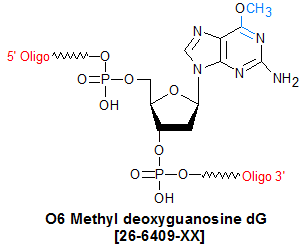
Modification : O6 Methyl dG
Catalog Reference Number
Category
Modification Code
5 Prime
3 Prime
Internal
Molecular Weight (mw)
Extinction Coeficient (ec)
Technical Info (pdf)
Absorbance MAX
Emission MAX
Absorbance EC
| Catalog No | Scale | Price |
| 26-6409-05 | 50 nmol | $416.00 |
| 26-6409-02 | 200 nmol | $416.00 |
| 26-6409-01 | 1 umol | $551.00 |
| 26-6409-03 | 2 umol | $416.00 |
| 26-6409-06 | 5 umol | $2,479.50 |
| 26-6409-10 | 10 umol | $1,769.00 |
| 26-6409-15 | 15 umol | $2,211.00 |
| Discounts are available for O6 Methyl dG! |
| Modification* Discount Price Structure |
|
1 site/order
|
List price
|
|
2 sites/order
|
10% discount
|
|
3 sites/order
|
20% discount
|
|
4 sites/order
|
30% discount
|
|
5-9 sites/order
|
50% discount
|
|
10+ sites/order
|
60% discount
|
|
*Exceptions apply
|
O6-Methyl-deoxyguanosine (O6-Me-dG) is classified as an O-alkyl purine, and O6-Me-dG-modified oligonucleotides are primarily used in studies of the role of DNA alkylating agents in mutagenesis and carcinogenesis, and in studies into possible enzymatic mechanisms involved in repair of DNA alkylation damage. Both in vitro and in vivo, O6-Me-dG DNA lesions are formed by reaction with N-nitrosamines (known carcinogens), particularly those found in tobacco smoke (for example, 4-(methylnitrosamine)-1-(3-pyridyl)-1-butanone (NNK)) (1,2). O6-Me-dG is highly mutagenic due to its strongly mis-pairing characteristics (DNA polymerases preferentially insert thymine opposite O6-Me-dG, leading to G-to-A transitions) (3). Generation of O6-Me-dG lesions in the K-ras proto-oncogene or p53 gene results in activation of the proto-oncogene or inactivation of p53, leading to loss of control over cell growth and cancer (4).O6-Me-dG lesions are repaired by the specialize repair protein O6-alkylguanine DNA alkyltransferase (AGT), which removes the methyl group (as well as other alkyl groups) from O6 via a "suicide" inactivation mechanism, thereby restoring the natural guanine base (5).
References
1. Hecht, S.S. Tobacco smoke carcinogens and lung cancer.
J. Natl. Cancer. Inst. (1999),
91: 1194-1210.
2. Hoffmann, D., Brunnemann, K.D., Prokopczyk, B., Djordjevic, M.V. Tobacco-specific N-nitrosamines and Areca-derived N-nitrosamines: chemistry, biochemistry, carcinogenicity, and relevance to humans.
J. Toxicol. Environ, Health (1994),
41: 1-52.
3. Warren,, J.J., Forsberg, L.J., Beese, L.S. The structural basis for the mutagenicity of O6-methyl-guanine lesions.
Proc. Natl. Acad. Sci. USA (2006),
103: 19701-19706.
4. Zochbauer-Muller, S., Gazdar, A.F., Minna, J.D.. Molecular pathogenesis of lung cancer.
Annual Review of Physiology (2002),
64: 681-708.
5. Zang, H., Fang, Q., Pegg, A.E., Guengerich, F.P. Kinetic analysis of steps in the repair of damaged DNA by human O6-alkylguanine-DNA alkyltransferase.
J. Biol. Chem. (2005),
280: 30873-30881.
- O6 Methyl dG
